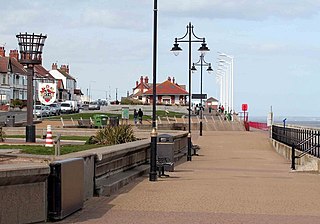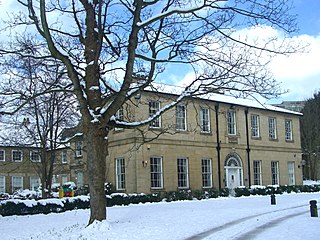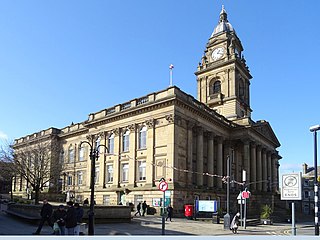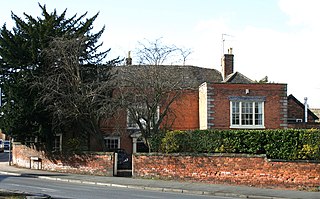
Selby Abbey is a former Benedictine abbey and current Anglican parish church in the town of Selby, North Yorkshire, England. It is Grade I listed.

Red House Museum was a historic house museum, built in 1660 and renovated in the Georgian era. It closed to the public at the end of 2016 but remains as a Grade II* listed building in Gomersal, Kirklees, West Yorkshire, England.

Bretton Hall is a country house in West Bretton near Wakefield, West Yorkshire, England. It housed Bretton Hall College from 1949 until 2001 and was a campus of the University of Leeds (2001–2007). It is a Grade II* listed building.

Hornsea is a seaside town and civil parish in the East Riding of Yorkshire, England. The settlement dates to at least the early medieval period. The town was expanded in the Victorian era with the coming of the Hull and Hornsea Railway in 1864. In the First World War the Mere was briefly the site of RNAS Hornsea Mere, a seaplane base. During the Second World War the town and beach was heavily fortified against invasion.

Selby District was a local government district of North Yorkshire, England, from 1974 to 2023. Its council was based in the town of Selby. The district had a population of 83,449 at the 2011 Census. The southernmost district of North Yorkshire, it bordered the City of York unitary authority, the Borough of Harrogate in North Yorkshire, the City of Leeds and City of Wakefield districts in West Yorkshire, the City of Doncaster in South Yorkshire, and the ceremonial county of the East Riding of Yorkshire.

Tadcaster is a market town and civil parish in North Yorkshire, England, 12 miles (19 km) north-east of Leeds and 10 miles (16 km) south-west of York. Its historical importance from Roman times onward was largely as the lowest road crossing-point on the River Wharfe until the construction of the A64 Tadcaster by-pass some 660 yards (600 m) to the south, in 1978. There are two rail crossings downstream of the town before the Wharfe joins the River Ouse near Cawood.

Cottingham is a large village and civil parish in the East Riding of Yorkshire, England. It lies 4 miles (6 km) north-west of the centre of Kingston upon Hull, and 6 miles (10 km) south-east of Beverley on the eastern edge of the Yorkshire Wolds. It forms part of Hull's Urban Area. It has two main shopping streets, Hallgate and King Street, which cross each other near the Church of Saint Mary the Virgin, and a market square called Market Green. Cottingham had a population of 17,164 residents in 2011, making it larger by area and population than many towns. As a result, it is one of the villages claiming to be the largest village in England.

Broom Hall is a historic house in the City of Sheffield, England that gives its name to the surrounding Broomhall district of the city. The earliest part of the house is timber-framed; it has been tree-ring dated to c1498, and was built by the de Wickersley family, whose ancestral home was at Wickersley. The de Wickersley family descended from Richard FitzTurgis, who co-founded Roche Abbey in South Yorkshire. The de Wickersley family later dropped their Norman name (FitzTurgis) in favour of the village they controlled.

Morley Town Hall is a municipal facility in Morley, West Yorkshire, England. The town hall, which is the meeting place of Morley Town Council, is a Grade I listed building.

Touchstones Rochdale is an art gallery, museum, local studies centre, visitor information centre and café forming part of the Central Library, Museum and Art Gallery in Rochdale, Greater Manchester, England. It is a Grade II listed building.

Ilkley Manor House, Ilkley, West Yorkshire, England, is a local heritage museum, art gallery, and live venue, and was established in the present building in 1961 to preserve local archaeological artefacts after the spa town expanded and much Roman material was lost. It was managed by Bradford Council Museums and Galleries department but had to be closed in 2013 owing to lack of funds. In order to keep the building open to the public, the Ilkley Manor House Trust was formed, and in April 2018, Bradford Council transferred the Manor House and three adjacent cottages to the Trust as a community asset transfer.

Wadworth Hall is a grade I listed Manor House, in the village of Wadworth, England. It was built in 1749 for the Wordsworth family by the renowned northern architect James Paine. It is currently a private residence and has been since approximately 1995. The house, however, has served a number of purposes over the past 250 years.

The Rookery, or 125 Hospital Street, is a substantial Georgian townhouse in Nantwich, Cheshire, England. It is at the end of Hospital Street, on the north side, at the junction with Millstone Lane. The existing building dates from the mid-18th century and is listed at grade II; English Heritage describes it as "good" in the listing. Nikolaus Pevsner describes it as "square and stately." It incorporates an earlier timber-framed house at the rear, which probably dates from the late 16th or early 17th century.

Morleys Hall, a moated hall converted to two houses, is situated at grid reference SJ 689 992 on Morleys Lane, on the edge of Astley Moss in Astley in the historic county of Lancashire and the ceremonial county of Greater Manchester, England. It was largely rebuilt in the 19th century on the site of a medieval timber house. The hall is a Grade II* listed building and the moat a scheduled ancient monument. Morleys is a private residence.

Greenbank is a former country house to the south of Chester, Cheshire, England. It was built in 1820 for John Swarbreck Rogers, a local glove manufacturer and mayor of Chester. From 1907 the house was occupied by Peter Jones, an Ellesmere Port businessman. He was a patron of the fine arts, who commissioned work from artists, and collected 18th-century furniture. In 1923 a doorway and a separate gatehouse were added, designed by C. H. Reilly. The building was converted into a college in about 1980. It is a stuccoed, flat-roofed building in two storeys with seven bays. The central three bays have a parapet higher than the others, giant pilasters, and panels decorated with garlands above tall windows. The architectural historian Nikolaus Pevsner describes it as "one of the best Georgian houses of Chester". The house is recorded in the National Heritage List for England as a designated Grade II listed building.
Bedford Hall is a late-medieval-house in Bedford, Leigh, Greater Manchester, England. It was leased to tenants by the Kighleys, absent lords of the manor of Bedford, and has been modified several times over the centuries becoming a farmhouse and now two houses. It was one of a group of timber-framed medieval halls, including Morleys Hall in Astley, located to the north of Chat Moss. It is a Grade II Listed building.

Grimston Park is a grade II* listed Georgian country house in Grimston, North Yorkshire, England, some 1.7 miles (3 km) south of Tadcaster. Since being owned by the Fielden family, it has been converted into a number of luxury homes.

Heathcote is a Neoclassical-style villa in Ilkley, West Yorkshire, England. Designed by architect Edwin Lutyens, it was his first comprehensive use of that style, making it the precursor of his later public buildings in Edwardian Baroque style and those of New Delhi. It was completed in 1908.

The church of St Mary the Virgin, Hemingbrough is a Grade I listed building in Hemingbrough, district of Selby, North Yorkshire, England. It is also known as Hemingbrough Minster.

St Oswald's Hall is a grade II* listed former church in Fulford, in south-eastern York, in England.




















